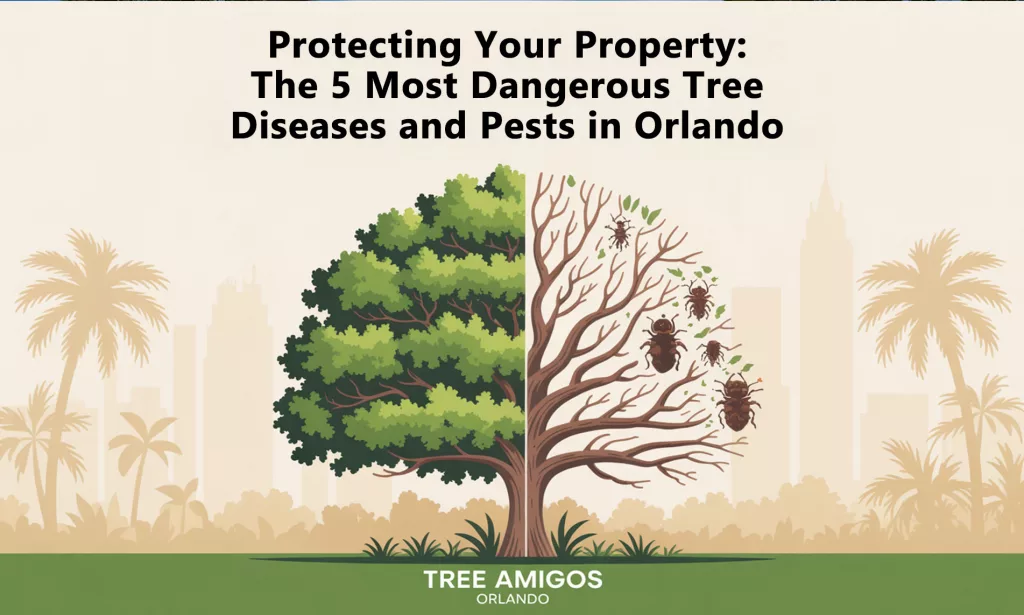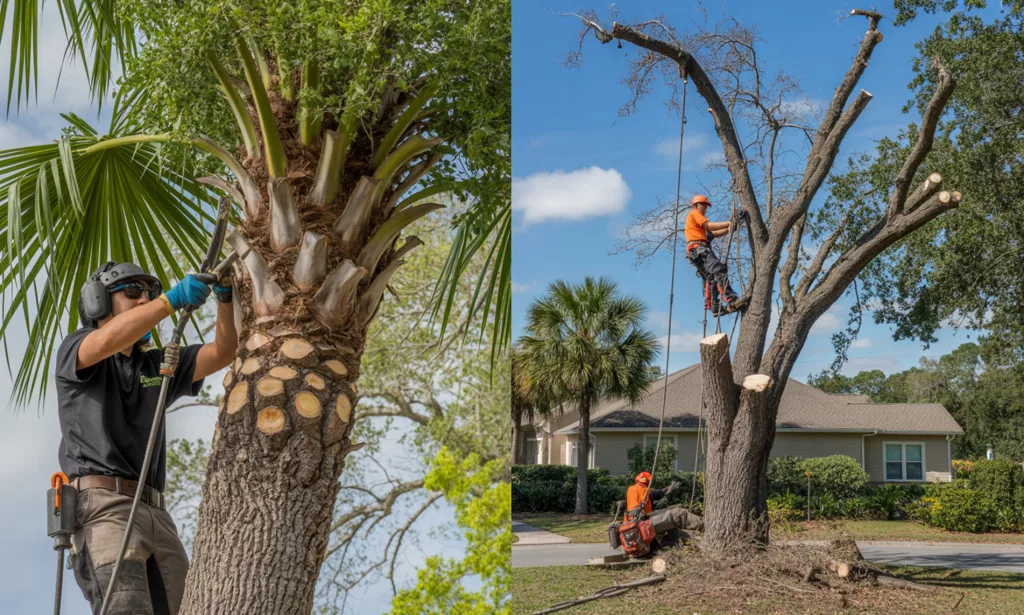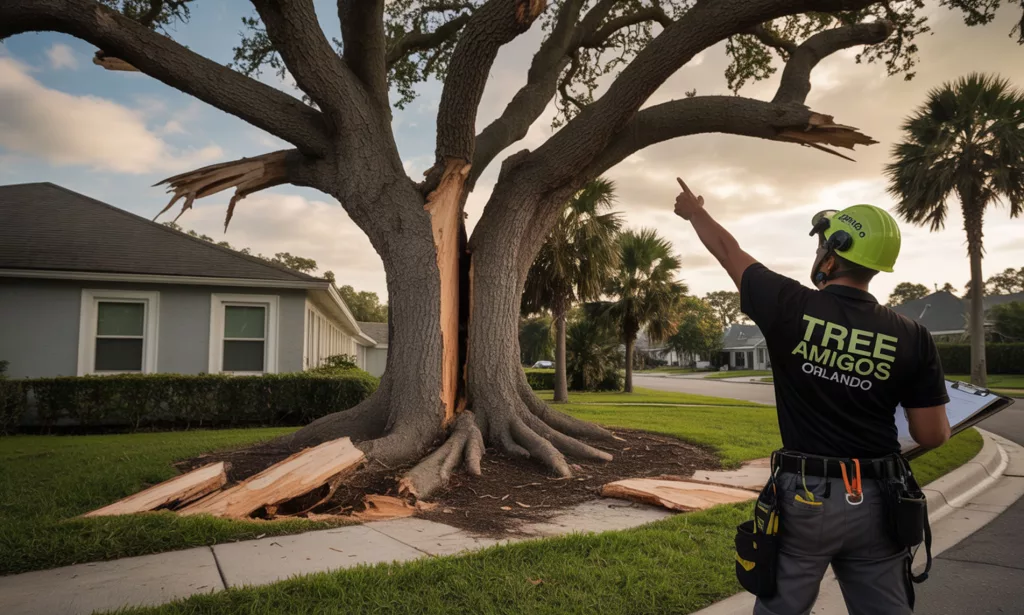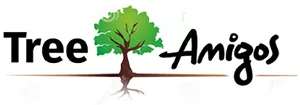- Tree Health & Disease
🌳 Protecting Your Property: The 5 Most Dangerous Tree Diseases and Pests in Orlando (and When to Call for Immediate Removal)
Providing professional tree trimming and removal in Orlando, Florida, and surrounding areas.

The Silent Threats to Your Landscape and Property Value
Orlando is famous for its lush, green landscapes and majestic mature trees. Live Oaks, Palms, and flowering ornamentals are the heart of Central Florida’s beauty and provide crucial shade and habitat. However, the same warm, humid climate that fosters this vibrant growth also makes our trees uniquely susceptible to some of the nation’s most aggressive diseases and invasive pests.
Ignoring these threats doesn’t just put your landscape at risk—it puts your Orlando property itself in jeopardy. A tree silently compromised by root rot or disease is a disaster waiting to happen, especially during our heavy storm seasons. When a tree is structurally unsound, it becomes a hazardous tree that is a liability for your family, your home, and your neighbor’s property.
As the leading experts in Orlando tree trimming and removal services, Tree Amigos Orlando has compiled this essential guide to the five most dangerous threats we see across Orange County. Knowing the signs is the first step; knowing when to call for professional Orlando tree removal is the vital next step in property protection.

The 5 Major Tree Health Threats Requiring Expert Orlando Tree Service
When dealing with high-risk issues, early diagnosis is everything. Waiting too long can turn a manageable trimming job into an unavoidable emergency removal.
1. Laurel Wilt: The Fast and Fatal Fungus
Laurel Wilt is perhaps the most devastating threat to trees in the Bay Area, known for its ability to kill large trees in a matter of weeks. It is a fungal disease carried by the invasive Redbay Ambrosia Beetle and has been spreading aggressively throughout Florida.
The Signs of Laurel Wilt
- Sudden, Permanent Browning: The most obvious sign is that all the leaves on a branch or even the entire canopy turn brown very quickly but remain attached to the tree.
- Wilting Foliage: Leaves often appear droopy before browning.
- The Ambrosia Beetle Frass: You may see tiny, toothpick-like tubes of sawdust (called frass) protruding from the bark, indicating the presence of the beetle.
Trees Affected by Laurel Wilt (The Redbay Family)
This disease primarily targets trees in the Lauraceae family, including the native Redbay, Sassafras, and, most notably, Avocado trees.
🚨 Expert Recommendation: Immediate Removal is Key
There is no effective cure for Laurel Wilt once symptoms are advanced. The moment a tree is confirmed to have the disease, immediate Orlando tree removal is necessary. The infected wood must be carefully disposed of to prevent the Ambrosia Beetle from emerging and spreading the deadly fungus to nearby susceptible trees. This is a containment issue, and professional, swift service is non-negotiable.
2. Ganoderma Root Rot: The Silent Killer of Mature Trees
Ganoderma Root Rot is arguably the most treacherous issue we deal with because it attacks the base and roots of the tree without showing immediate symptoms in the canopy. This fungal disease decays the wood at the tree’s structural base, making the tree incredibly prone to failure, often collapsing without warning during high winds.
How to Identify Ganoderma Root Rot
- The Conk or Shelf Mushroom: The definitive sign is the presence of a white/red-brown shelf-like mushroom (conk) growing directly on the lower trunk, near the base, or on exposed roots. The conk is the fungal fruiting body.
- Weakened, Sparse Canopy: Because the roots are damaged, the tree cannot absorb nutrients, leading to smaller, yellowing leaves or dieback in the crown.
- Trunk Bleeding or Slime: Dark, slimy patches may appear on the lower trunk.
Why This Fungus is an Orlando Tree Removal Priority
Ganoderma infects a wide variety of hardwoods, including the iconic Live Oak, Royal Palm, and Maple—all common and often massive trees in Orlando neighborhoods. If a Ganoderma conk is present, the internal decay is already extensive. Tree Amigos Orlando treats this as an immediate hazard tree situation, requiring professional assessment and often prompt hazardous tree removal. You should never stand near a tree displaying this fungus during a storm.
3. Palm Diseases: Lethal Yellowing and Fusarium Wilt
Palms define the Orlando aesthetic, but they are vulnerable to a host of specific, lethal diseases. Two of the most common and aggressive are Lethal Yellowing (LY) and Fusarium Wilt.
The Symptoms and Trees at Risk
Lethal Yellowing (LY)
- Trees Affected: Highly lethal to Coconut Palms and various Date Palms.
- Symptoms: Premature drop of fruit, flower loss, followed by the browning and death of the lower fronds, progressing rapidly up the canopy.
Fusarium Wilt
- Trees Affected: Primarily the majestic Queen Palm and the resilient Date Palm.
- Symptoms: Fronds on one side of the palm (often starting near the bottom) turn brown, wilt, and curl inward. The affected fronds look distinctly dead and often droop in a characteristic V-shape.
The Danger of Palm Disease Contagion
Unlike some other diseases, palm wilts can be easily spread by contaminated pruning tools. If a palm is infected, an attempted trim using tools that were just used on a diseased palm can spread the infection. This is why professional Orlando tree trimming with sterilized equipment is critical for palm maintenance. If the disease is advanced, the palm becomes brittle, and total removal is necessary to prevent falling fronds or the trunk snapping.
4. Asian Citrus Psyllid and Citrus Greening (HLB)
While many homeowners don’t consider citrus trees a high-risk removal, they are a staple in Central Florida yards and are under constant attack from the Citrus Greening disease (Huanglongbing, or HLB), which is transmitted by the tiny Asian Citrus Psyllid.
The Impact on Your Property
Citrus Greening is a bacterial disease that cripples the tree’s ability to transport nutrients. While it may not cause sudden structural failure, it will lead to:
- Unsightly Appearance: Mottled, yellowing leaves and misshapen, bitter fruit.
- Decline and Death: Over time, the tree will lose vigor, making it susceptible to other pests and eventually leading to its demise.
🍊 Treatment Focus: Proactive Tree Trimming and Care
For young citrus trees, aggressive management, including strategic tree trimming to remove infected branches and systemic insecticide treatments, can sometimes prolong life. However, for heavily infected, non-producing trees, professional Orlando tree removal is often the most economical and pragmatic solution to clear space and prevent the pest population from migrating.
5. Bark Beetles and Wood Borers (Attacks on Stressed Trees)
A large category of small, hard-to-spot pests—including various bark beetles and wood borers—prey on trees that are already weakened by drought, construction damage, or nutrient deficiencies. They typically tunnel under the bark, cutting off the tree’s circulatory system.
Key Warning Signs
- Small, Round Holes: Tiny, perfect entry and exit holes on the trunk or branches.
- Sawdust or Boring Dust: Fine sawdust around the base of the tree or caught in the bark crevices.
- Pitch Tubes: On pine trees, the tree will try to push the beetles out, creating small, hardened resin or pitch tubes on the bark.
Expert Intervention for Borers
If the infestation is caught early and is confined to a single limb, precise Orlando tree trimming (pruning the infected branch) and deep-root fertilization to boost the tree’s overall health can save it. However, if the main trunk is heavily riddled with borer holes, the structural integrity is compromised, and the decision will quickly shift to a professional tree removal service to protect the property.

Knowing When to Choose Trimming vs. Tree Removal in Orlando
The ultimate goal of a professional arborist inspection is to determine if your tree can be saved (trimming) or must be taken down (removal).
Signs You Need Expert Orlando Tree Trimming (Maintenance)
- Isolated Dieback: You notice a small area of dead wood or disease confined to one or two upper branches.
- Overgrowth: Branches are rubbing together or growing too close to your home, roofline, or power lines.
- Preventative Health: Your arborist identifies an issue (like early-stage insect tunneling or minimal canopy thinning) that can be corrected by boosting the tree’s health and removing only the compromised wood.

Signs You Need Immediate Orlando Tree Removal (Safety)
- Fungal Conks: The presence of Ganoderma, shelf mushrooms, or other large fungal growths at the base of the trunk.
- Severe Lean or Cracks: Sudden or worsening lean, deep cracks in the trunk or major limbs, or heaving soil around the base.
- Cabling Issues: You find your tree’s cabling or bracing system has failed, or the trunk is rotting where the cable is attached.
- Lethal Disease Diagnosis: A certified arborist confirms a fatal, aggressive disease with no cure (like advanced Laurel Wilt).
- Structural Failure: More than 50% of the tree’s wood is dead, or it is located too close to a primary structure to risk future failure.
📞 Don’t Guess—Trust Your Local Certified Arborists
Attempting to diagnose or treat these major tree threats yourself is risky. Many diseases are difficult to distinguish from simple stress, and improper trimming can actually accelerate decline or spread contagious diseases.
The experienced team at Tree Amigos Orlando offers comprehensive, on-site diagnostics. We are trained to identify the subtle signs of these five dangerous threats and will provide an honest, safety-first recommendation—whether that’s a targeted Orlando tree trimming service to save your beloved tree or a safe, efficient Orlando tree removal service to protect your property and comply with all local Orange County tree regulations.
Contact us today for a full property assessment and secure the health and safety of your Central Florida landscape.

Posted onTrustindex verifies that the original source of the review is Google. I have used Tree Amigos two times. They gave me a quote and came quickly to do the job. They were very professional and kind and did superb work! I would definitely recommend them and will use them again for tree trimming maintenance.Posted onTrustindex verifies that the original source of the review is Google. I have used them in the past, they lived up to my previous experience with them. Easy to work with and very efficient. Will definitely use them again in the future.Posted onTrustindex verifies that the original source of the review is Google. We had 4 tall pine trees removed by the Tree Amigos team led by Luis and they performed over and above what was promised. Highly recommended especially for difficult tree removal jobs.Posted onTrustindex verifies that the original source of the review is Google. Luis and his crew did a great job. I’m very pleased.Posted onTrustindex verifies that the original source of the review is Google. I have used Tree Amigos many times and always had a positive experience. Recently had a huge tree taken down in my backyard and couldn’t be more pleased with their work!Posted onTrustindex verifies that the original source of the review is Google. Tree Amigos is always fast and very fair priced.Posted onTrustindex verifies that the original source of the review is Google. Luis was super responsive and provided a fair price. They were able to grind two stumps by the next business day and were understanding of the needs on site.Posted onTrustindex verifies that the original source of the review is Google. I have had Tree Amigos help with tree trimming and sod replacement. Great team with great service.Load more
